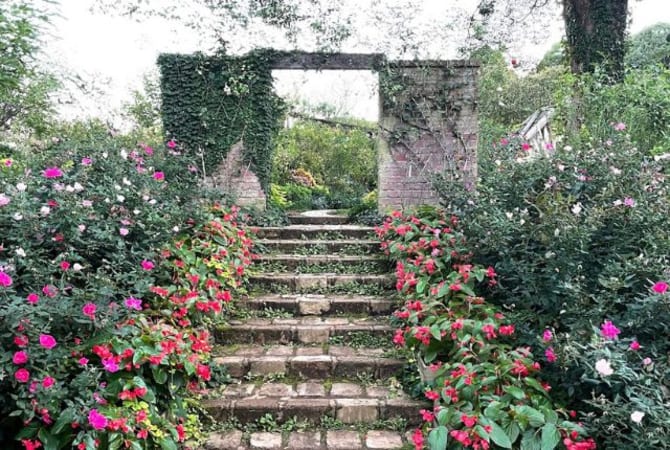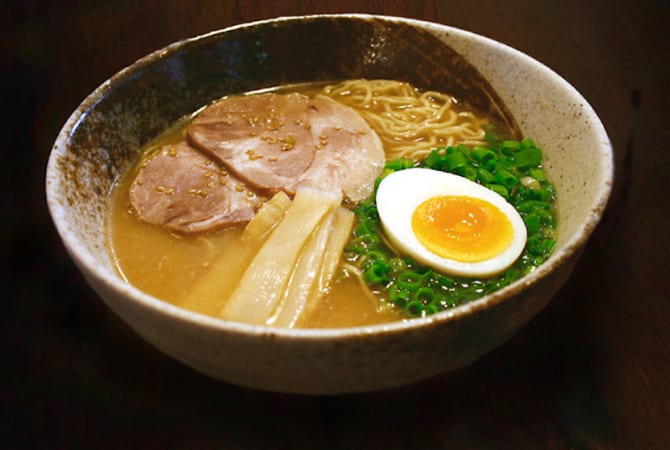
Spring Beyond Sakura: Flowers in Japan That Are Just As Beautiful
Spring Beyond Sakura: Flowers in Japan That Are Just As Beautiful
- There are other Japanese flowers that bloom during spring aside from sakura or cherry blossoms.
- Catch wisteria, nemophila, and shibazakura in different sites in Japan during their peak season from April to May.
When we think of spring in Japan, sakura (also known as cherry blossoms) is the first bloom that comes to mind. But did you know that there are other Japanese spring flowers that are just as mesmerizing?
Some of these other flowers bloom around or after the peak of sakura season, giving spectators more sites to enjoy and allowing them to feel more of Japan’s springtime charm. Curious about when and where to find them? Read on.
1. Wisteria in Kawachi Wisteria Garden, Fukuoka Prefecture

Wisteria tunnel in Kawachi Wisteria Garden during spring.
- Kawachi Wisteria Garden is a private garden known for its beautiful wisteria blooms.
- Only those who purchase tickets in advance can access the park during the blooming period to avoid congestion.
Kawachi Wisteria Garden in Kitakyushu City is known for its whimsical wisteria (“fuji” in Japanese) tunnels and domes. Wisteria is considered a symbol of love and longevity in Japan. It’s often referenced in poems, plays, and traditional designs. In popular culture, wisteria is a key element in the hit manga series Demon Slayer: Kimetsu No Yaiba; its author Koyoharu Gotouge hails from Fukuoka where this garden is located.
From late April until Golden Week (a series of Japanese public holidays taking place within one week at the end of April to the beginning of May each year), waves of purple, pink, and white wisteria cover the garden. The flowers hang everywhere from the wisteria trellis area and along the 80-meter and a 110-meter tunnels within the site. The park also has an area which allows visitors to see the blanket of these Japanese spring flowers from a higher vantage point.
P.S. To avoid park congestion during peak season, only those who purchase tickets in advance at convenience stores can enter the park during the blooming period. These tickets can be used only during the indicated time and date and are non-refundable.
Ticket prices go from approximately JPY500 to JPY1,500 but are subject to specific terms and conditions that may vary depending on park conditions. Starting this year, tickets may be purchased online in advance as well. Additional fees on top of the initial ticket purchase apply required upon arrival at the park.
WHEN
Late April to early May
WHERE
Address: 2-2-48 Kawachi, Yahata Higashi Ward, Kitakyushu City, Fukuoka Prefecture 805-0045
Access: From Hakata Station, ride a train to Yahata Station via the Kagoshima Main Line (1 hour). Upon alighting, take a 25-minute cab ride to the Garden.
Operating Schedule: Late April to early May, 8AM to 6PM and mid-November to early December, 9AM to 5PM (schedule subject to the projected flowering season).
Official site: https://kawachi-fujien.com/
Ticketing site: https://webket.jp/pc/ticket/index?fc=52406&ac=9000
2. Nemophila in Hitachi Seaside Park, Ibaraki Prefecture

© Ibaraki Prefectural Government
- Hitachi Seaside Park is known for its gorgeous flower gardens all year round.
- Aside from nemophila, you can also see tulips, narcissus, and rape blossoms during this season.
Hitachi Seaside Park in Ibaraki Prefecture is known for featuring seasonal flowers and vast natural landscapes across its 350 hectares. During spring, Miharashi no Oka Hill, which is situated inside the park, gets covered with beautiful nemophila or rurikarakusa: quaint, round-shaped, sky-blue flowers. This soft and mesmerising shade is considered rare among flowers and plants all over the world, making it incredibly unique. Nemophila symbolizes love, success, and happiness, which makes the park feel like a celebration of these positive ideals.
These spring flowers found in Japan usually bloom around April to May every year. Tulips, narcissus, and rape blossoms also fill the park during this season.
Tickets can be availed on-site and the prices range from JPY450 to JPY500 during the off-season and JPY460 to JPY1,000 during the peak season.
WHEN
Mid-April to early-May (2023 forecast)
WHERE
Address: 605-4, Aza-Onuma, Mawatari, Hitachinaka City, Ibaraki Prefecture 312-0012, Japan
Access: From Tokyo Station, take the shinkansen to Katsuta Station (around 1.5 hours). After alighting the train, head to Bus Stop No. 2 and take a 30-minute bus ride to Hitachi Seaside Park.
Operating Schedule: Park hours vary depending on the season.
Official site: https://hitachikaihin.jp/en/
3. Shibazakura in Chausuyama Highlands, Aichi Prefecture

Shibazakura in Chausuyama Highlands during spring. ©︎Chausuyama Highlands Association
- Shibazakura covers Chausuyama Highlands’s 22,000 square-meter landscape during springtime.
Shibazakura (creeping phlox) got its name from its similarities to cherry blossoms. The name translates to ‘lawn cherries’ or ‘lawn cherry blossoms’ in English. But it definitely has its own charm!
You’ll be in awe as soon as you step foot on Shibazakura-no-oka Hill in Chausuyama Highlands during spring. Shades of pink, lilac, sky-blue, and white shibazakura cover the 22,000-square-meter site from mid-May to early June, creating a vast carpet of blooms as far as your eyes can see.
Some locations in Japan hold shibazakura festivals that require guests to pay an entrance fee to participate, but the one celebrated in Aichi Prefecture is free for everyone to enjoy.
If you want to check out the landscape from a different perspective, you can also try the sightseeing ski lift that takes you high in the air to view the flowers from above. This experience costs around JPY500 to JPY800 per person.
WHEN
Mid-May to early June
WHERE
Address: 70-185 Goshodaira, Sakauba, Toyone Village, Kitashitara District, Aichi Prefecture 449-0405
Access: Approximately 2 hours and 10 minutes by car from Nagoya.
Operating Schedule: Mid-May to early June (schedule subject to the projected flowering season)
Official website: https://intl.okuminavi.jp/en/spot/detail/26/
Which of these blooms are you most excited to see this spring?
Discover more of Japan. Follow us on Facebook and Instagram for fun facts and quick tips about Japan.


















































